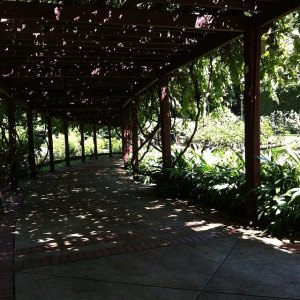Yet another Ramadhan has passed, and yet another less than satisfactory ending. Eid ul Fitr on the first day of the month of Syawal in the Hijri Calendar is supposed to be a celebration of a ‘return to fitra’, a state of natural being in the order of the universe, the purposeful existence in the eyes of the Creator, a rebirth of sorts. Instead, a sense of restlessness took its place; vocational challenges, coupled with sub-optimal health and peppered with some navel gazing made up the ingredients of this deflatingly served dish.
Why was this so? Approximately seven sun-rotations ago, the mutawwif who guided my family’s conditionally compulsory Meccan pilgrimage had remarked that the whole Hajj experience was intended as a training ground for the times that came after. It made sense at the time, for the rigours and experience of Hajj is not quickly forgotten and would serve well months after leaving the Holy Land. I had inadvertently applied this logic to the month of Ramadhan as well; it seemed entirely reasonable that the ‘training ground’ rationale was equally applicable here. Having just experienced my forty-ninth cycle in my lifetime, I have come to the conclusion that it was just the opposite: the rest of the year was, in fact, preparation for the momentous month.
There were several reasons: firstly, the cyclical nature of the twelve months meant that we would repeatedly be, God willing, facing Ramadhan again and again. It is as if we are at a sports training facility practising for an annual event. Secondly, the cyclical nature also infers that there should be improvements in the future cycles. As is often the case, one often leaves the rigours of Ramadhan far behind in the other months, typically reverting to type, lending gravitas to the observable phenomenon of ‘Ramadhan Muslims’. This is due to the fact that the ‘training’ and ‘tournament’ is not planned to be cumulative but rather a turn of the hamster wheel. Thirdly, within Ramadhan is probably the most important night of all nights, the Night of a Thousand Nights, better known as ‘Lailatul Qadr’. This mysteriously placed night (where there are signs given, but only God knows for sure) contained within the last ten days of Ramadhan promises multifold rewards for those who seek and experience it. This phenomenon breaks down the “training-tournament” analogy, but implies an attitudinal concept instead: to achieve the full rewards in Ramadhan, it is not enough only to be a Competitor, but one also needs to be an active Seeker.
Taking this strand of thinking further, perhaps only the Restless Seeker stands a chance of fully experiencing the Nectars of Ramadhan. Many yearn for the ecstasy of having maximised one’s Ramadhan but piercing that veil would probably require an intertwined tapestry of ponderance and prayers, whose exposition is far beyond the capacity and capability of this writer. Perhaps a more achievable aim would be to explore one important strand of that lofty goal with a preparation of an oft-practised but maybe un-maximised action: that of Quranic Recitation.
One of the names for Ramadhan is Shahr ul Quran, the month of Quran. Not only was the first verse of the Quran (Surah al-Alaq, the 96th) revealed during this month, but also reciting the whole Quran is highly recommended and is common practice among Muslims. In this regard, I have insofar failed miserably at achieving this. Often when I finally get around to reading it, it is slowed down by looking at the meaning and trying to ascertain the message. Therein lies the heart of the problem; I could never seem to grasp the Quran as a whole, and therefore fail to contextualise what I am reading. For one trained as an architect who designs buildings and townships with complex relationships that need to function as a whole (and add to that a penchant for phenomenology), and now as a management consultant who constructs strategies for transformation programmes for companies and systems that need to run in tandem, the Quran is but a black box of seemingly incoherent parts.
The search for a Gestalt-conception of the Quran has been a personal pre-occupation for many years. I have been searching through many English translations of the Quran, as well as books about the Book especially concerning thematics and conceptual frameworks. The former had taken me through from the de facto Yusuf Ali translation (I much prefer ‘ye olde’ version with a poem to introduce every surah), to the dogmatic Mawdudi, the poetic Sayyid Qutb, the new standard bearer Mohsin Khan and ending with the fascinating Muhammad Asad. For the latter, Muhammad al-Ghazali et al helped with thematics, M.M. Al-Azami with the history, Shetha Al-Dargazeli with the names of Surahs, and many others with specific interpretations of different Surahs, as well as Naisaburi’s exposition of why certain Surahs were revealed. Furthermore, the works of two of my favourite Sheikhs, Ustaz Nouman Ali Khan and Shaikh Yasir Qadhi (these two often through videos) were copiously referred. However, the real breakthrough happened in the last five years, starting with my discovery of Amin Ahsan Islahi ‘Tadabbur-i-Qur’an’ and Muntasir Mir’s study of his approach, further elaborated in Nouman Ali Khan and Sharif Randhawa’s ‘Divine Speech’. It was from that last book that I found earlier though recent works of Raymond Farrin (the discoverer of the Ring Theory in the Quran sometimes seen in videos) and Neal Robinson, both currently under study.
It is my hope to synthesise the knowledge from these and other sources into a holistic conceptual framework of the Quran, using Farrin’s Ring Theory as a point of trajectory. The primary objective remains as lending meaning to Quranic Recitation during the next Ramadhan, God willing. Gestalt and Visual Communication approaches will also be integrated, devices that make up much of my training and current way of thinking. Honestly, it is really for my own convenience and comprehension, but I hope it works for you too.
The next post will introduce some structural mechanics of the Quran, including how the Surahs may be grouped (we shall discuss approaches by different scholars), as well as the Ring Theory. Stay tuned.



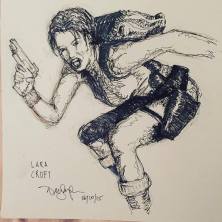






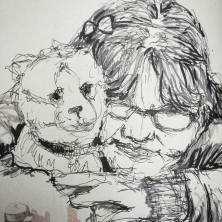



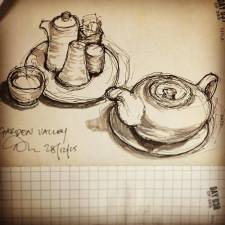
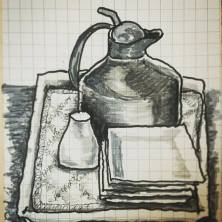







 The set comprises felt nibs in sizes XS (very thin, good for detailing), S (best for drawing), F (good for outlines and emphasis) and B (brush nib which I have never used before and wanted to try). The featured image at the top of this post are depict the four pens and their line weights. I also purchased a Rotring Clutch pencil with a built-in sharpener (at the top of the cap).
The set comprises felt nibs in sizes XS (very thin, good for detailing), S (best for drawing), F (good for outlines and emphasis) and B (brush nib which I have never used before and wanted to try). The featured image at the top of this post are depict the four pens and their line weights. I also purchased a Rotring Clutch pencil with a built-in sharpener (at the top of the cap).











 So I had more tools at my disposal, but needed more guidance. In order to ensure I do not stray from the original intent of producing comics, I was looking for books that would help me sketch better, and ink better. God’s grace certainly shone through that day when I was rummaging through MPH at One Utama and came across 2 books that fit both criteria. The first being James Hobb’s “Sketch your World: Essential Techniques for Drawing on Location”, a guide that looks at various techniques and methods for drawing on-the-go, an imperative skill that I need to acquire if I were ever to rediscover and further develop my drawing chops. It even intersperses the chapters with profiles of featured artists, delving a little deeper on their particular methods. Heartily recommended, this book got a 4.5 stars rating on Amazon, and 5/5 at Barnes & Noble!
So I had more tools at my disposal, but needed more guidance. In order to ensure I do not stray from the original intent of producing comics, I was looking for books that would help me sketch better, and ink better. God’s grace certainly shone through that day when I was rummaging through MPH at One Utama and came across 2 books that fit both criteria. The first being James Hobb’s “Sketch your World: Essential Techniques for Drawing on Location”, a guide that looks at various techniques and methods for drawing on-the-go, an imperative skill that I need to acquire if I were ever to rediscover and further develop my drawing chops. It even intersperses the chapters with profiles of featured artists, delving a little deeper on their particular methods. Heartily recommended, this book got a 4.5 stars rating on Amazon, and 5/5 at Barnes & Noble! The other delightful find was John Paul Lowe’s “Foundations in Comic Book Art”. While not strictly a ‘how-to’ book nor is it a history of sequential art, this book manages to find an amazing balance of method and meaning, whilst using his own artwork as well as those from Savannah College of Art and Design (SCAD) where he has been teaching for over 20 years. Whilst the composition and construction of objects may seem a tad overblown (although useful or those really starting with basics), his exposition on inking (hurray!) is extensive and instructive for a neophyte like moi. Touche! interestingly, this book also received the same ratings as the above!
The other delightful find was John Paul Lowe’s “Foundations in Comic Book Art”. While not strictly a ‘how-to’ book nor is it a history of sequential art, this book manages to find an amazing balance of method and meaning, whilst using his own artwork as well as those from Savannah College of Art and Design (SCAD) where he has been teaching for over 20 years. Whilst the composition and construction of objects may seem a tad overblown (although useful or those really starting with basics), his exposition on inking (hurray!) is extensive and instructive for a neophyte like moi. Touche! interestingly, this book also received the same ratings as the above!



